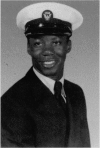Abstract
Sickle cell trait continues to be the leading cause of sudden death for young African Americans in military basic training and civilian organized sports. The syndrome may have caused the death of up to 10 college football players since 1974 and, as recently as 2000, was suspected as the cause of death of three U.S. Army recruits. The penal military-style boot camps in the United States and the recent death of two teenagers with sickle cell trait merits renewed vigor in the education of athletic instructors, the military and the public about conditions associated with sudden death in individuals with sickle cell trait.
Full text
PDF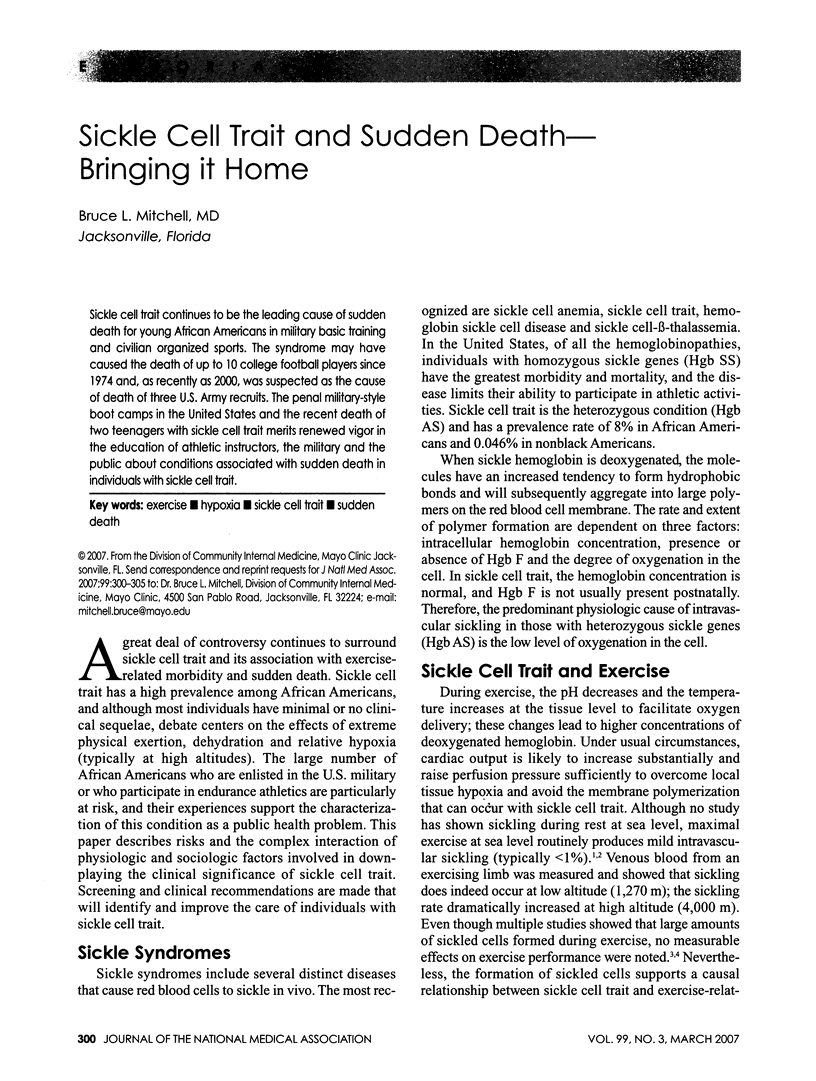
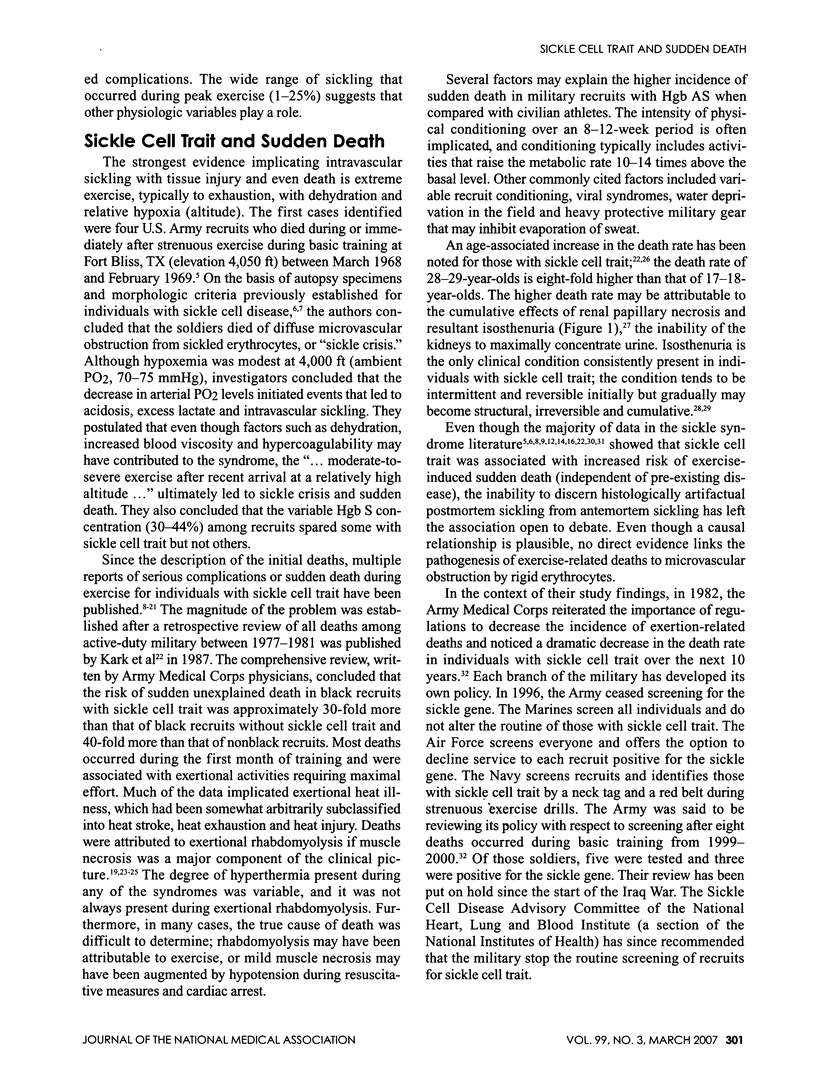
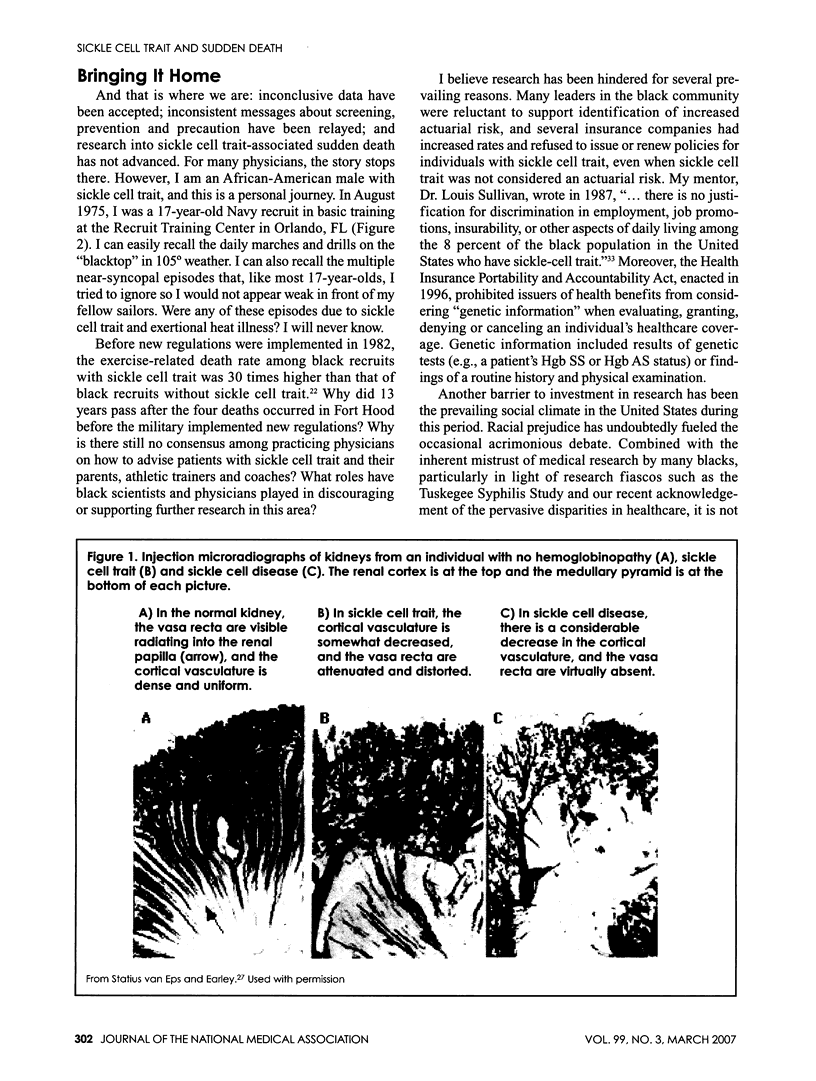

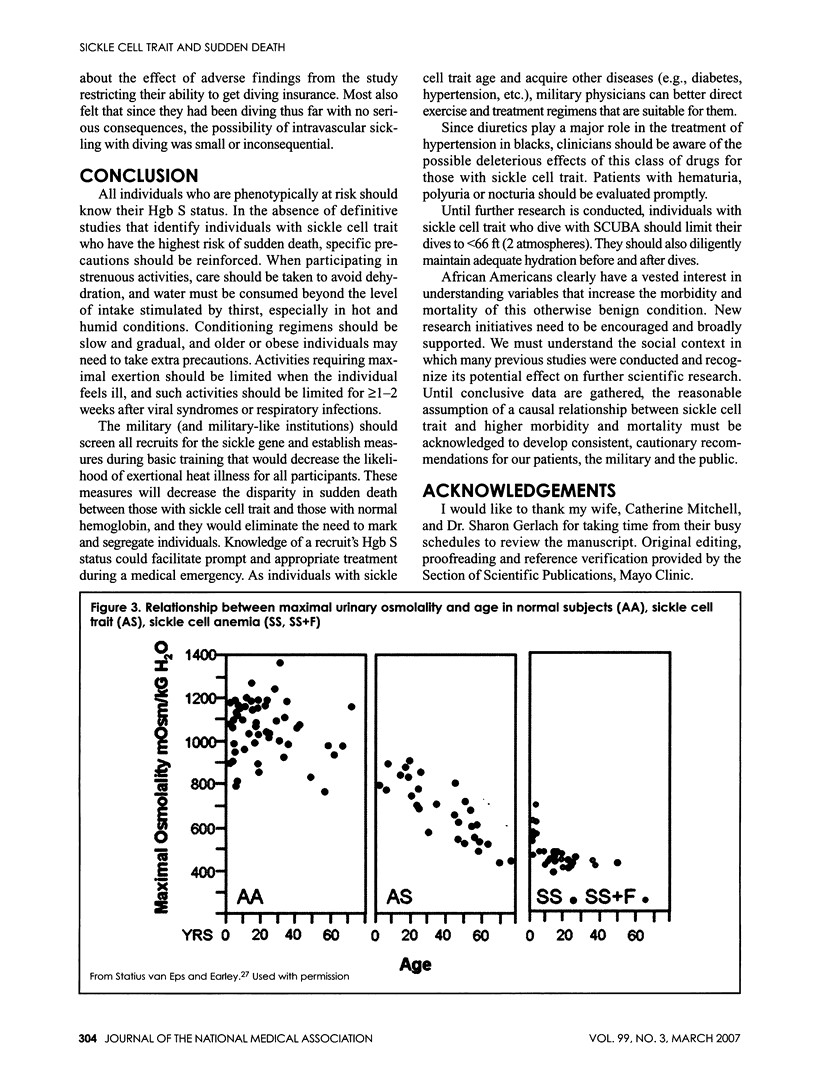

Images in this article
Selected References
These references are in PubMed. This may not be the complete list of references from this article.
- Alpert B. S., Flood N. L., Strong W. B., Blair J. R., Walpert J. B., Levy A. L. Responses to exercise in children with sickle cell trait. Am J Dis Child. 1982 Nov;136(11):1002–1004. doi: 10.1001/archpedi.1982.03970470046013. [DOI] [PubMed] [Google Scholar]
- Burchard Esteban González, Ziv Elad, Coyle Natasha, Gomez Scarlett Lin, Tang Hua, Karter Andrew J., Mountain Joanna L., Pérez-Stable Eliseo J., Sheppard Dean, Risch Neil. The importance of race and ethnic background in biomedical research and clinical practice. N Engl J Med. 2003 Mar 20;348(12):1170–1175. doi: 10.1056/NEJMsb025007. [DOI] [PubMed] [Google Scholar]
- Clarke P. M., Gray A. M., Briggs A., Farmer A. J., Fenn P., Stevens R. J., Matthews D. R., Stratton I. M., Holman R. R., UK Prospective Diabetes Study (UKDPS) Group A model to estimate the lifetime health outcomes of patients with type 2 diabetes: the United Kingdom Prospective Diabetes Study (UKPDS) Outcomes Model (UKPDS no. 68). Diabetologia. 2004 Oct 27;47(10):1747–1759. doi: 10.1007/s00125-004-1527-z. [DOI] [PubMed] [Google Scholar]
- Diggs L. W. The sickle cell trait in relation to the training and assignment of duties in the armed forces: III. Hyposthenuria, hematuria, sudden death, rhabdomyolysis, and acute tubular necrosis. Aviat Space Environ Med. 1984 May;55(5):358–364. [PubMed] [Google Scholar]
- Gabow P. A., Kaehny W. D., Kelleher S. P. The spectrum of rhabdomyolysis. Medicine (Baltimore) 1982 May;61(3):141–152. doi: 10.1097/00005792-198205000-00002. [DOI] [PubMed] [Google Scholar]
- Gardner J. W., Kark J. A. Fatal rhabdomyolysis presenting as mild heat illness in military training. Mil Med. 1994 Feb;159(2):160–163. [PubMed] [Google Scholar]
- George C. Acute renal failure due to rhabdomyolysis in sickle cell trait. Intensive Care Med. 1979 Nov;5(4):204–205. doi: 10.1007/BF01683941. [DOI] [PubMed] [Google Scholar]
- Grossman R. A., Hamilton R. W., Morse B. M., Penn A. S., Goldberg M. Nontraumatic rhabdomyolysis and acute renal failure. N Engl J Med. 1974 Oct 17;291(16):807–811. doi: 10.1056/NEJM197410172911601. [DOI] [PubMed] [Google Scholar]
- Hieb L. D., Alexander A. H. Bilateral anterior and lateral compartment syndromes in a patient with sickle cell trait. Case report and review of the literature. Clin Orthop Relat Res. 1988 Mar;(228):190–193. [PubMed] [Google Scholar]
- Hynd R. F., Bharadwaja K., Mitas J. A., Lord J. T. Rhabdomyolysis, acute renal failure, and disseminated intravascular coagulation in a man with sickle cell trait. South Med J. 1985 Jul;78(7):890–891. doi: 10.1097/00007611-198507000-00033. [DOI] [PubMed] [Google Scholar]
- ITANO H. A., KEITEL H. G., THOMPSON D. Hyposthenuria in sickle cell anemia: a reversible renal defect. J Clin Invest. 1956 Sep;35(9):998–1007. doi: 10.1172/JCI103360. [DOI] [PMC free article] [PubMed] [Google Scholar]
- Jones S. R., Binder R. A., Donowho E. M., Jr Sudden death in sickle-cell trait. N Engl J Med. 1970 Feb 5;282(6):323–325. doi: 10.1056/NEJM197002052820607. [DOI] [PubMed] [Google Scholar]
- Kark J. A., Posey D. M., Schumacher H. R., Ruehle C. J. Sickle-cell trait as a risk factor for sudden death in physical training. N Engl J Med. 1987 Sep 24;317(13):781–787. doi: 10.1056/NEJM198709243171301. [DOI] [PubMed] [Google Scholar]
- Kennedy A. P., Walsh D. A., Nicholson R., Adams J. G., 3rd, Steinberg M. H. Influence of HbS levels upon the hematological and clinical characteristics of sickle cell trait. Am J Hematol. 1986 May;22(1):51–54. doi: 10.1002/ajh.2830220108. [DOI] [PubMed] [Google Scholar]
- Knochel J. P. Rhabdomyolysis and myoglobinuria. Annu Rev Med. 1982;33:435–443. doi: 10.1146/annurev.me.33.020182.002251. [DOI] [PubMed] [Google Scholar]
- Koppes G. M., Daly J. J., Coltman C. A., Jr, Butkus D. E. Exertion-induced rhabdomyolysis with acute renal failure and disseminated intravascular coagulation in sickle cell trait. Am J Med. 1977 Aug;63(2):313–317. doi: 10.1016/0002-9343(77)90247-9. [DOI] [PubMed] [Google Scholar]
- Martin T. W., Weisman I. M., Zeballos R. J., Stephenson S. R. Exercise and hypoxia increase sickling in venous blood from an exercising limb in individuals with sickle cell trait. Am J Med. 1989 Jul;87(1):48–56. doi: 10.1016/s0002-9343(89)80482-6. [DOI] [PubMed] [Google Scholar]
- Nathan David M., Cleary Patricia A., Backlund Jye-Yu C., Genuth Saul M., Lachin John M., Orchard Trevor J., Raskin Philip, Zinman Bernard, Diabetes Control and Complications Trial/Epidemiology of Diabetes Interventions and Complications (DCCT/EDIC) Study Research Group Intensive diabetes treatment and cardiovascular disease in patients with type 1 diabetes. N Engl J Med. 2005 Dec 22;353(25):2643–2653. doi: 10.1056/NEJMoa052187. [DOI] [PMC free article] [PubMed] [Google Scholar]
- Phillips M., Robinowitz M., Higgins J. R., Boran K. J., Reed T., Virmani R. Sudden cardiac death in Air Force recruits. A 20-year review. JAMA. 1986 Nov 21;256(19):2696–2699. [PubMed] [Google Scholar]
- Ramírez A., Hartley L. H., Rhodes D., Abelmann W. H. Morphological features of red blood cells in subjects with sickle cell trait: changes during exercise. Arch Intern Med. 1976 Sep;136(9):1064–1066. doi: 10.1001/archinte.1976.03630090086021. [DOI] [PubMed] [Google Scholar]
- Rodgers G. P. Sickle-cell trait and physical training. Evidence for improved fitness. Arch Intern Med. 1988 May;148(5):1019–1020. [PubMed] [Google Scholar]
- Rosenthal M. A., Parker D. J. Collapse of a young athlete. Ann Emerg Med. 1992 Dec;21(12):1493–1498. doi: 10.1016/s0196-0644(05)80068-x. [DOI] [PubMed] [Google Scholar]
- Sateriale M., Hart P. Unexpected death in a black military recruit with sickle cell trait: case report. Mil Med. 1985 Nov;150(11):602–605. [PubMed] [Google Scholar]
- Schrier R. W., Henderson H. S., Tisher C. C., Tannen R. L. Nephropathy associated with heat stress and exercise. Ann Intern Med. 1967 Aug;67(2):356–376. doi: 10.7326/0003-4819-67-2-356. [DOI] [PubMed] [Google Scholar]
- Sears D. A. The morbidity of sickle cell trait: a review of the literature. Am J Med. 1978 Jun;64(6):1021–1036. doi: 10.1016/0002-9343(78)90458-8. [DOI] [PubMed] [Google Scholar]
- Sherry P. Sickle cell trait and rhabdomyolysis: case report and review of the literature. Mil Med. 1990 Feb;155(2):59–61. [PubMed] [Google Scholar]
- Statius van Eps L. W., Pinedo-Veels C., de Vries G. H., de Koning J. Nature of concentrating defect in sickle-cell nephropathy. Microradioangiographic studies. Lancet. 1970 Feb 28;1(7644):450–452. doi: 10.1016/s0140-6736(70)90836-6. [DOI] [PubMed] [Google Scholar]
- Sullivan L. W. The risks of sickle-cell trait: caution and common sense. N Engl J Med. 1987 Sep 24;317(13):830–831. doi: 10.1056/NEJM198709243171309. [DOI] [PubMed] [Google Scholar]
- THOMA G. W. The incidence and significance of sickle cell disease in deaths subject to medicolegal investigation. Am J Med Sci. 1953 Oct;226(4):412–418. doi: 10.1097/00000441-195310000-00008. [DOI] [PubMed] [Google Scholar]
- Weisman I. M., Zeballos R. J., Martin T. W., Johnson B. D. Effect of Army basic training in sickle-cell trait. Arch Intern Med. 1988 May;148(5):1140–1144. [PubMed] [Google Scholar]
- Zimmerman J., Granatir R., Mummert K., Cioffi R. Sickle crisis precipitated by exercise rhabdomyolysis in a patient with sickle cell trait: case report. Mil Med. 1974 Apr;139(4):313–315. [PubMed] [Google Scholar]




